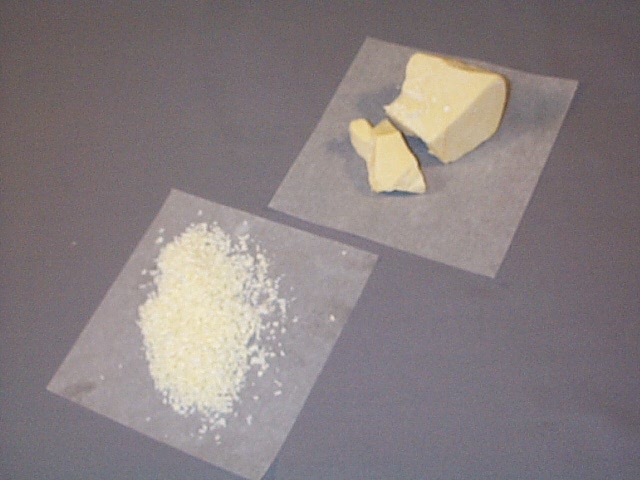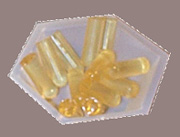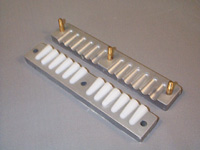|
|
Suppository Bases
Suppository bases may be conveniently classified as according to their composition and physical properties:
- Oleaginous (fatty) bases
- Water soluble or miscible bases
|

|
Oleaginous Bases
Oleaginous bases include Theobroma Oil and synthetic triglyceride mixtures.
 Theobroma
Oil or cocoa butter is used as a suppository base because, in large
measure, it fulfills the requirements of an ideal base. At ordinary room temperatures
of 15° to 25°C (59° to 77°F), it is a hard, amorphous
solid, but at 30° to 35°C (86° to 95°F), i.e., at body
temperature, it melts to a bland, nonirritating oil. Thus in warm climates,
theobroma oil suppositories should be refrigerated. Theobroma
Oil or cocoa butter is used as a suppository base because, in large
measure, it fulfills the requirements of an ideal base. At ordinary room temperatures
of 15° to 25°C (59° to 77°F), it is a hard, amorphous
solid, but at 30° to 35°C (86° to 95°F), i.e., at body
temperature, it melts to a bland, nonirritating oil. Thus in warm climates,
theobroma oil suppositories should be refrigerated.
Particular attention must be given to two factors when preparing suppositories
with cocoa butter base. First, this base must not be heated above 35°C
(95°F) because cocoa butter is a polymorphic compound and if overheated
will convert to a metastable structure that melts in the 25° to 30°C
(77° to 86°F) range. Thus, the finished suppositories would melt
at room temperature and not be usable.
The second factor is the change in melting point caused by adding certain
drugs to cocoa butter suppositories. For example, chloral hydrate and phenol
tend to lower the melting point. It may be necessary to add spermaceti or
beeswax to raise the melting point of finished suppositories back to the desired range.
- The newer synthetic triglycerides consist of hydrogenated vegetable oils. Their advantage over cocoa butter is that they do not exhibit polymorphism.
They are, however, more expensive. Some of the bases are single entity formulations.
Some of the names may denote a series of bases. In a series, the bases are
varied to give a range of melting points. For example, Fattibase® is a
single entity base that consists of triglycerides from palm, palm kernel,
and coconut oils. Wecobee® is a series of bases. Wecobee FS, M, R, and
S are all made from triglycerides of coconut oil. But FS has a melting point
range of 39.4 to 40.5°C, M has a range of 33.3 to 36.0°C, R has a
range of 33.9 to 35.0°C, and S has a range of 38.0 to 40.5°C. Other
triglyceride type bases include Dehydag®, Hydrokote®, Suppocire®, and Witepsol®.
Water Soluble/Water Miscible Bases
Water soluble/water miscible bases are those containing glycerinated
gelatin or the polyethylene glycol (PEG) polymers.
 Glycerinated Gelatin is a useful suppository base, particularly for
vaginal suppositories. It is suitable for use with a wide range of medicaments including alkaloids, boric acid, and zinc oxide. Glycerinated gelatin suppositories are translucent, resilient, gelatinous solids that tend to dissolve or disperse slowly in mucous secretions to provide prolonged release of active ingredients. Glycerinated Gelatin is a useful suppository base, particularly for
vaginal suppositories. It is suitable for use with a wide range of medicaments including alkaloids, boric acid, and zinc oxide. Glycerinated gelatin suppositories are translucent, resilient, gelatinous solids that tend to dissolve or disperse slowly in mucous secretions to provide prolonged release of active ingredients.
Suppositories made with glycerinated gelatin must be kept in well-closed containers in a cool place since they will absorb and dissolve in atmospheric moisture. In addition, those intended for extended shelf-life should have a preservative added, such as methylparaben or propylparaben, or a suitable combination of the two. To facilitate administration, glycerinated gelatin suppositories should be dipped in water just before use.
 Polyethylene Glycol Polymers have received much attention as suppository bases in recent years because they possess many desirable properties. They are chemically stable, nonirritating, miscible with water and mucous secretions, and can be formulated, either by molding or compression, in a wide range of hardness and melting point. Like glycerinated gelatin, they do not melt at body temperature, but dissolve to provide a more prolonged release than theobroma oil. Polyethylene Glycol Polymers have received much attention as suppository bases in recent years because they possess many desirable properties. They are chemically stable, nonirritating, miscible with water and mucous secretions, and can be formulated, either by molding or compression, in a wide range of hardness and melting point. Like glycerinated gelatin, they do not melt at body temperature, but dissolve to provide a more prolonged release than theobroma oil.
Certain polyethylene glycol polymers may be used singly as suppository bases but, more commonly, formulas call for compounds of two or more molecular weights mixed in various proportions as needed to yield a finished product of satisfactory hardness and dissolution time.
Since the water miscible suppositories dissolve in body fluids and need
not be formulated to melt at body temperature, they can be formulated with
much higher melting points and thus may be safely stored at room temperature.
Examples of various PEGs used in suppository bases are:
|
|
|
|
|
|
|
|
| 300 |
10% |
| 1540 |
65% |
| 3350 |
25% |
|
| Silica Gel |
25 mg |
| PEG 1450 |
2.3 gm |
|
|
|